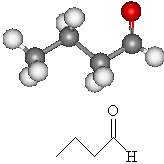In this, we will consider Oxygen that has a double bond to Carbon only (called Carbonyl group), which can be classified as Ketone or Aldehyde , depending on the Carbon Oxygen is bonding to as below:
Note that "R" stands for any alkyl.
IUPAC Names
Aldehydes
- Find the longest carbon chain containing the aldehyde group. Carbon with aldehyde group is always numbered as first one.
- Then, the name is formed by changing the -e of the alkane one to -al.
- Examples : HCHO = methanal, CH3CH2CH2CHO = butanal.
Ketones
- Find the longest carbon chain containing the kerone group.
- Then, the name is formed by changing the -e of the alkane one to -one.
- The position of the carbonyl group is denoted by a number.
- Example : CH3-CO-CH3 = 2-propanone.
Physical Properties
The carbonyl group is polar as the EN of the oxygen is greater than carbon. So, oxygen has negeative polar while carbon has positive so that Aldehydes and Ketones can do hydrogen bonding with water. They are more soluble in water if they are not too big - more than 4 carbons. However, polar in Aldehydes and Ketones gives them somewhat higher boiling and melting points. (But still lower than some like alcohol or carboxylic acid.)
Reference : BCC M.5 Chemistry Book.
http://en.wikipedia.org/wiki/Aldehyde
http://en.wikipedia.org/wiki/Ketone http://www.chm.bris.ac.uk
http://www.elmhurst.edu


No comments:
Post a Comment